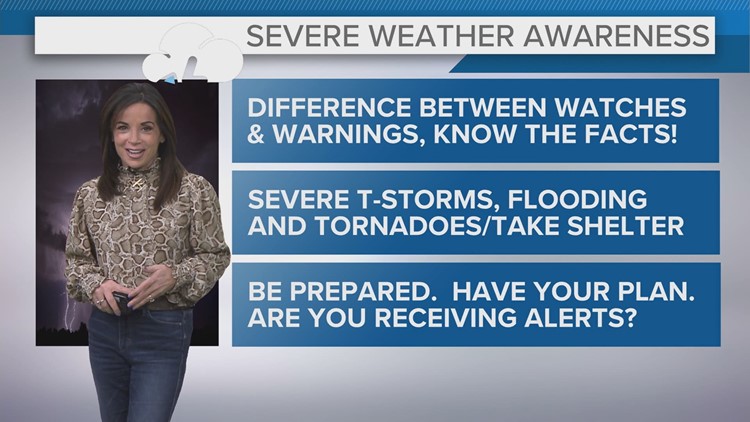CLEVELAND — I hear from so many of you with questions about tornadoes, severe thunderstorms and how snow may impact your commute. There is a sense of anxiety attached to a lot of your weather-related questions that aren't focused on sunny blue skies.
This "weather anxiety" is quite easy to predict. It comes directly from NOT being able to control the weather. Think about it. We truly are NOT in control.
This is why it's so important to be prepared and informed about what to do. This knowledge and readiness will give you that sense of being in control. You will already have a plan in place ahead of any weather scenario and know what to do to keep you and your family safe.
This may shock you, but according to CDC data, 48% of Americans don’t have emergency supplies and 44% don’t even have a basic first aid kit in their home.
Now is the time to get those things in order. Be sure your entire household knows where to find these supplies. You can get ahead of the storm now by having flashlights with new batteries in each bedroom.
Ok, now let's start with some basics like the difference between a weather WATCH and a weather WARNING.
WATCH VS WARNING
Simply put, a WATCH means conditions are favorable for whatever the specific weather condition is threatening. A WARNING means the threatening weather is happening or is imminent.
For example, a TORNADO WATCH means conditions are favorable for storms that could produce tornadoes in a specified area. However, it does NOT mean tornadoes are actually occurring at that time.
A TORNADO WARNING means a tornado IS occurring or about to and you should TAKE COVER immediately. It means a tornado that has either been spotted or is indicated by radar.
Taking shelter during a tornado may save your life.
According to The National Weather Service, here's what you should do when a tornado strikes:
- At Your House: If you are in a tornado warning, go to your basement, safe room, or an interior room away from windows. Don't forget pets if time allows.
- At Your Workplace or School: Follow your tornado drill and proceed to your tornado shelter location quickly and calmly. Stay away from windows and do not go to large open rooms such as cafeterias, gymnasiums, or auditoriums.
- Outside: Seek shelter inside a sturdy building immediately if a tornado is approaching. Sheds and storage facilities are not safe. Neither is a mobile home or tent. If you have time, get to a safe building.
- In a vehicle: Being in a vehicle during a tornado is not safe. The best course of action is to drive to the closest shelter. If you are unable to make it to a safe shelter, either get down in your car and cover your head, or abandon your car and seek shelter in a low-lying area such as a ditch or ravine
According to the National Weather Service, a severe thunderstorm is defined as "a thunderstorm that produces 1-inch hail or larger in diameter and/or has winds that equal or exceed 58 miles an hour," whereas a tornado is defined as "a violently rotating column of air, with circulation reaching the ground. Tornadoes almost always start as a funnel cloud."
FLOODING
Despite all the "hype" and curiosity centered around tornadoes, flooding/flash flooding kills more people than tornadoes every year in the United States.
A Flash Flood is defined by the National Weather Service as "heavy or excessive rainfall in a short period of time, generally less than 6 hours."
Flash Flood WATCHES vs WARNINGS work exactly the same as explained above. Remember, WATCH means conditions are favorable for the specific weather condition whereas WARNING means conditions are occurring.
Spring and summer weather hazards are top of mind right now. Educate yourself and your family.
According to the Ohio Committee for Severe Weather Awareness, "preparing in advance and knowing which types of alerts work best for you and your household is important and could potentially save your life, or the life of someone else."
STAYING WEATHER READY ON YOUR PHONE
The WKYC Weather app will offer an interactive radar, local forecast using your GPS location, and customized weather alerts no matter where you are to keep you weather-ready.
Also, NOAA Weather Radio (NWR) is a nationwide network of radio stations broadcasting continuous weather information directly from the nearest National Weather Service office. NWR broadcasts official Weather Service warnings, watches, forecasts and other hazard information 24 hours a day, 7 days a week. NWRs are a great source of real-time weather forecasts.
The options are countless. The FEMA App allows you to receive real-time weather and emergency alerts, send notifications to loved ones, locate emergency shelters in your area, create preparedness plans and more.
It's time to get ready. Hopefully, most of our weather will be non-threatening in nature, but in the event that is not the case, you will know what to do!



